Cahokia Mounds
Introduction
Text-to-speech Audio
Featuring the largest prehistoric manmade mound in North America, Cahokia Mounds Historic Site in Collinsville, IL enriches the area with Native History and stunning views of local landscapes. As a National and World recognized site, this historic landmark provides visitors with ample opportunity to learn about Native culture and lasting influences in Southern Illinois.
Images
Artifacts discovered at Cahokia, including figurines, flint sherds, shells, pottery and ceramics, and tools
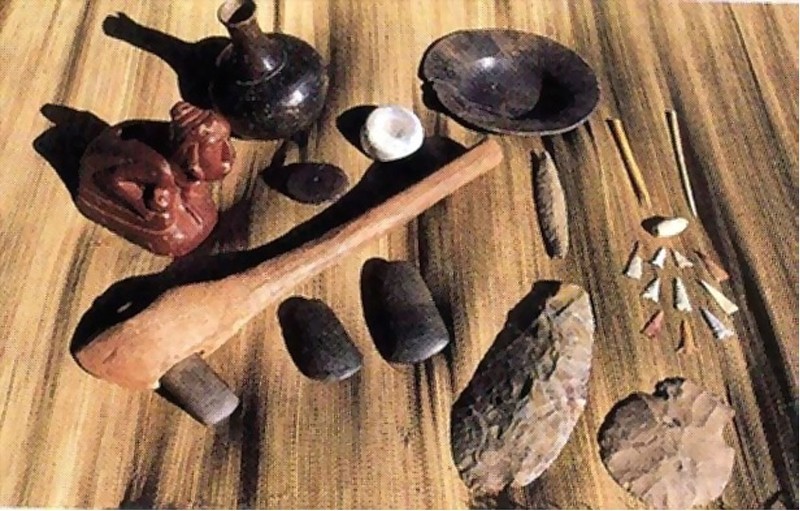
Clay Statuette
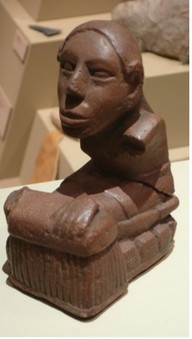
Mound 72, a burial
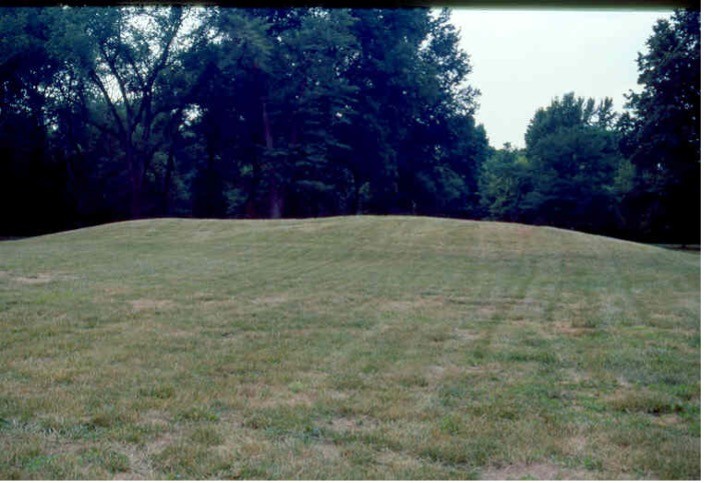
Copper plates discovered by Mound 34
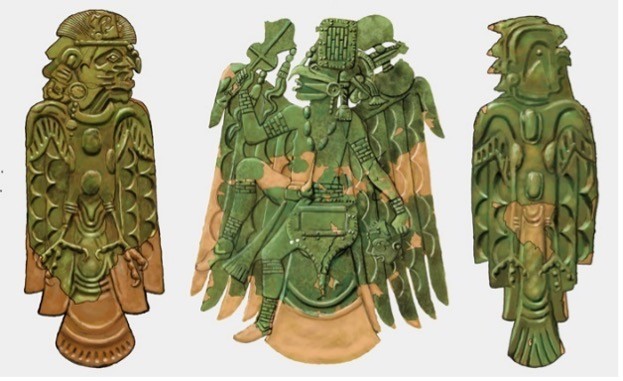
Mound 34, site of a copper workshop
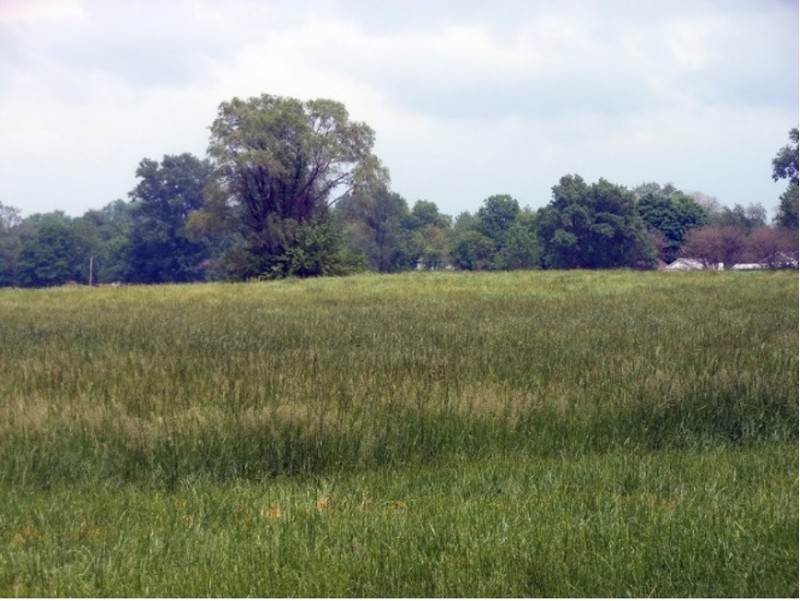
Monks Mound
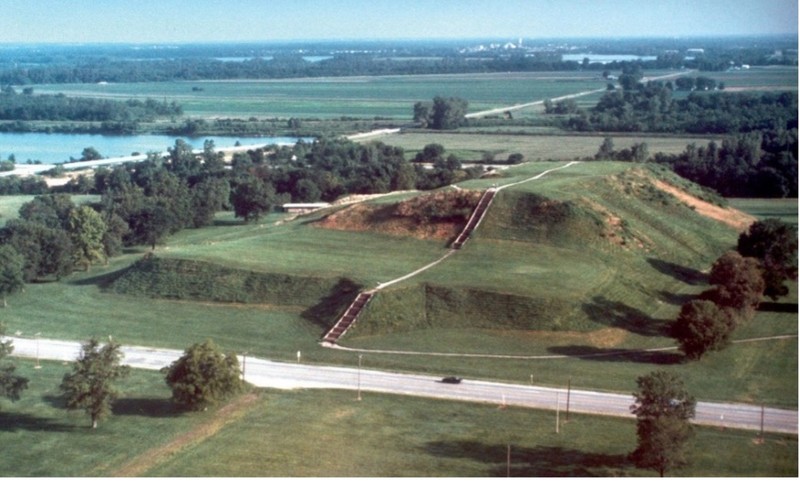
The Ramey Tablet
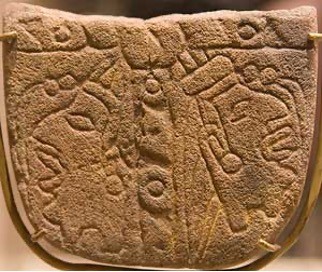
The Birdman Tablet
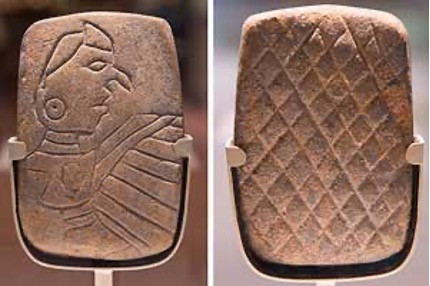
Backstory and Context
Text-to-speech Audio
Designated as a National Historic Landmark in 1964 and a World Heritage Site in 1982, Cahokia Mounds State Historic Site covers an area of 2,200 acres and is North America’s largest pre-Columbian city. At its peak (1100-1200 CE), historical records estimate that the city may have been home to as many as 20,000 people (see timeline below). Over 104 identified mounds exist within the site, with more lying beyond the current park boundaries. Monks Mound is the largest prehistoric manmade mound in North America (100 feet high, 1,000 feet long, and 800 feet wide with a 14-acre base). Monks Mound overlooked a great plaza surrounded by a 2-mile stockade called the Palisade. Constructed around 1175 CE, it composed some 20,000 poles with guard towers distributed at 70-foot intervals and was thought to have been rebuilt four times.
Examination of the soil layers composing the mounds indicates that people constructed them gradually over centuries. There have been three types of mounds described at Cahokia: platform mounds (possibly used for political or religious rituals supporting structures), conical mounds, and ridge-top mounds used as burial sites or to mark significant places. Historians believe that the ruling class lived on top of the platform mounds in wooden structures; many were buried with jewelry and ornaments signifying their importance.
Unfortunately, road and housing construction, as well as modern agricultural practices, destroyed many of Cahokia's mounds. Though less than 24 mounds have been examined, those mounds provided a wealth of information and artifacts that illuminate early Native American life in Illinois.
Major Discoveries at Mounds 72 and 34
One of the most interesting discoveries has been the contents of ridgetop Mound 72, first described in 1967. It has been described as one of the most shocking archaeological finds in North America. Within the mound were five mass graves containing 20-50 bodies each. Many more received burial individually or in groups above and around the mass graves. A total of 270 bodies were interred between 1000-1200 CE. Some of the buried bodies appeared to be people of high status. Among the dead in the “beaded burial” was a man in his forties resting on some 20,000 shell ornaments and in excess of 800 arrows, along with a staff and stones used in games. With him were four men lacking heads and hands and 53 young women who may have been sacrifices.
Reexamining the mound’s contents in 2016, researchers determined that there were two central bodies, a male and a female, placed on top of one another. They were lying on and surrounded by beads, and some of the other bodies were arranged in pairs. Burials of males and females of high status, and the discovery of other male and female pairs in the beaded burial, have changed the view that Cahokia was male-dominated. In addition, most of the stone figurines unearthed so far are female and reflective of life and fertility. These artifacts, among other types of evidence, indicate that women held a significant place in the culture.
Other significant artifacts found at Cahokia included raw and worked copper, arrowheads, knives, pottery, stone tools, and shells. In addition, researchers found artifacts associated with games including rings, hoops, pins, balls, and dice. Artifacts of particular interest are the Birdman Tablet and the Ramey Tablet. The former sandstone tablet includes a depiction of a man’s beaked head and the wings of a bird with crisscrossed lines resembling snakeskin across the back of the tablet. These images reflect the Native interpretation of the three worlds: heaven, the mortal world, and the underworld. On the latter sandstone tablet, dating from about 1250 CE, is a depiction thought to be “Red Horn,” a powerful Native American mythic hero. The heads show ear spools, beaded forelocks, and hair buns. The Madison County Historical Society Museum in Edwardsville houses the Ramey Tablet today.
Woodhenge
In the early 1960s, plans were underway for the construction of Interstate 255. The original plan, later rerouted, would have destroyed a portion of the Cahokia site. Archeologists hurriedly attempted to record and recover as much information and artifacts as they could. When researchers examined excavation maps for the area west of Monks Mound, they discovered numerous arcs of pits; further excavation revealed five circles of postholes of increasing diameters from the period 1100-1200 CE. The placement of red cedar posts in these pits aligned with the sunrise during certain times of the year, serving as a calendar to mark the summer and winter solstices and vernal and autumnal equinoxes. The construction of Woodhenge represents an impressive series of astronomical observations by Mississippian people.
Social and Political Position
Cahokia held a location that positioned it well for becoming a center for a trade network. Indigenous people produced and traded hardware in the region, such as hoes with flint blades and axes with shaped stone heads. There is evidence of trade at great distances: copper from Michigan, shells from the Gulf of Mexico and the Atlantic Ocean, chert from Oklahoma, and mica from the Carolinas.
What happened to Cahokia?
The reason Native groups abandoned Cahokia by 1300 CE remains a mystery. Researchers propose a variety of explanations, including environmental catastrophes such as extended drought or flooding. Other explanations include overuse of resources such as timber, or disease and warfare, but there are no confirmed explanations for the demise of Cahokia.
Cahokia Mounds Timeline
700: Late Woodland people established in the Cahokia area.
800: Emergent Mississippi culture develops. Coincided with the adoption of large-scale,
intensive maize agriculture.
900: transformation to Mississippian continues and Cahokia expands
1000:AD 1050 “Big Bang”
1100: AD 1100-1200 “Golden Age” of Cahokia. Population expands to 20,000 people.
Woodhenges appear.
AD 1150: Last building is erected on the summit of Monks Mound.
AD 1175 First of four two-mile palisade walls built around central Cahokia.
1200: Population slowly declines
1300: Cahokia is gradually abandoned by the late 1300s.
1400: People of the Oneota culture from the north establish small villages in the area.
1600: In the early 1600s, Indians of the Illiniwek confederacy moved into this area, including the
Cahokia sub-tribe.
Written by Reed Richardson, Edited by Jessica Guldner
Sources
Belknap, Lori. “New Discoveries from Cahokia’s ‘Beaded Burial’.” Cahokia Mounds Museum Society, <https://cahokiamounds.org/new-discoveries-from-cahokias-beaded-burial/>, accessed April 2022.
Benson, Larry V., Timothy R. Pauketat, and Edward R. Cook. “Cahokia’s Boom and Bust in the Context of Climate Change.” American Antiquity 74, no. 3 (2009): 467–83, <http://www.jstor.org/stable/20622439>, accessed April 2022.
“Cahokia Mounds.” ScienceViews.Com, <https://scienceviews.com/indian/cahokia.html#:~:text=The%20Cahokia%20Mounds%20were%20discovered,made%20a%20National%20Historic%20Land>, accessed May 2022.
“Cahokia Mounds, Illinois – Largest Archeological Site in North America.” Legends of America, <https://www.legendsofamerica.com/il-cahokia/>, accessed May 2022.
Fowler, Melvin L. “The Cahokia Atlas: A Historical Atlas of Cahokia Archeology.” Illinois Historic Preservation Agency, <https://libsysdigi.library.illinois.edu/oca/Books2008-06/cahokiaatlashist00fowl/cahokiaatlashist00fowl.pdf >, accessed April 2022.
Mark, Joshua J. “Cahokia.” World History Encyclopedia, <https://www.worldhistory.org/cahokia/>, accessed May 2022.
Pauketat, Timothy R. “Refiguring the Archaeology of Greater Cahokia.” Journal of Archaeological Research 6, no. 1 (1998): 45–89, <http://www.jstor.org/stable/41053152>, accessed April 2022.
Seppa, Nathan. “Ancient Cahokia: Metropolitan Life on the Mississippi.” The Washington Post, 1997, <https://www.washingtonpost.com/wp-srv/national/daily/march/12/cahokia.htm>, accessed May 2022.
Schilling, Timothy. “THE CHRONOLOGY OF MONKS MOUND.” Southeastern Archaeology 32, no. 1 (2013): 14–28, <http://www.jstor.org/stable/24780124>, accessed April 2022.
“The History of Cahokia’s Five Woodhenges.” Digital Research Library of Illinois History, <https://drloihjournal.blogspot.com/2019/06/the-cahokia-woodhenge.html>, accessed April 2022.
https://en.wikipedia.org/wiki/Cahokia
Yates, Diana “Fresh look at burials, mass graves, tells a new story of Cahokia.” Illinois News Bureau, University of Illinois Urbana-Champaign, 2016, <https://news.illinois.edu/view/6367/391694>, accessed May 2022.
Yates, Diana. “'Revealing Greater Cahokia' details research on ancient North American metropolis.” Illinois News Bureau, University of Illinois Urbana-Champaign, 2019, <https://news.illinois.edu/view/6367/742413>, accessed May 2022.
